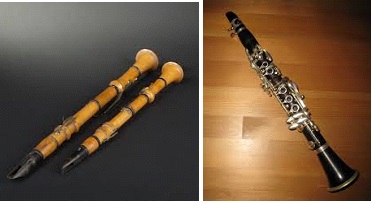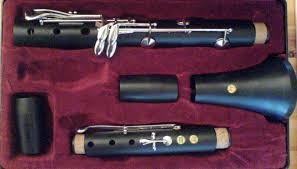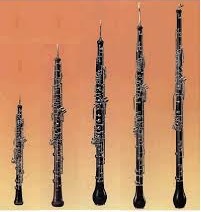
In ancient times, shepherds always had the leisure, time and inclination to make music. As years passed by, some shepherds also learnt to carve musical instruments from reeds and wood. The result was a single–reed mouthpiece instrument, a forerunner to the modern day Clarinet. Belonging to the family of woodwind single–reed instruments, the Clarinet is also classified as a single–reed aero–phone type with keys. The word Clarinet comes from ‘clarion’ which means ‘a little trumpet’. It was developed from the ‘chalumeau’ instrument of the renaissance era. A most recent addition to the woodwind family, the Clarinet is the last to be used in symphony orchestra. Clarinets have the largest pitch of all the woodwind instruments. Also, the timbre of a Clarinet consists of three instruments namely the chalumeau, clarion and altissimo. Making sounds with a Clarinet is much easier than making music with other musical instruments. Portable, easy to learn and a modern invention, the Clarinet is the most important part of an orchestra as well as the instrumental music. Rich, mellow, gentle, melodic and throaty, it is the ability of the Clarinet to play smooth and expressive music. A person who plays the Clarinet is called a clarinettist. Let us learn more about this instrument.
The invention of the Clarinet is credited to Johann Christoph Denner, an instrument maker from Nuremberg. Evolved from the Chalumeau, the difference between Chalumeau and the Clarinet was of two keys. The Chalumeau was one and a half octave shorter than the Clarinet. Denner’s son, Jakob began with the production of Clarinets with two keys and wide bores. By the end of the eighteenth century, instruments with five keys became the standard. In 1812, the German Clarinettist Iwan Mueller made a new model with thirteen keys and the Clarinet was established by itself with this modification. The bass Clarinet was invented in 1772 by Giles Lot but the modified modern day bass Clarinet traces to Adolphe Sax’s instrument introduced in 1838.

To play the Clarinet, the reed is placed on the lower lip and is pressed against the lower teeth while the upper teeth grip the closed side of the mouthpiece. The reed is controlled and is set in motion by way of lip pressure, air pressure and the points of contact between the reed and the lower lip. On blowing, the vibrating reed sends little puffs of air into the air column inside the instrument body that causes the air column to vibrate. Notes are produced on the Clarinet either by opening or closing of the tone holes or keys with one finger or a combination of fingers.

The components or parts of a Clarinet include the mouthpiece, tube, bore, bell, key or tone holes, ligature, joints and barrel.

A Clarinet is made from wood (ebony, rosewood), metal ivory, plastic, rubber and resin. Normally made out of a single reed, this reed is attached to the mouthpiece by a ligature. The reed is manufactured from any material. It is joined to the mouthpiece by a ligature. The mouthpiece is made from rubber, plastic, metal or any other material. Ligatures are made of metal. The formation of the mouth around the moth piece is called the embouchure. The main body of Clarinets is made up of an upper joint, barrel, lower joint with holes and most of the keys. The keys are covered with felt pads or synthetic pads (modern instruments) to prevent air leakage. The flared part at the end is called the bell. All these different parts are assembled and joined together to make a Clarinet.

A Clarinet is a key instrument played in classical music. It is also often used as a solo instrument. Clarinet is an important part of musical ensembles such as the big bands, military bands and jazz. Orchestras, romantic orchestra, concerts, symphonies, chamber music and solo works incorporate the Clarinet. Compositions made of two or more Clarinets are very popular in the 20th century classical music. Popular music of samba from Brazil uses the Clarinet. The Clarinet is a very popular component of wedding music, folklore and traditional music.

Types of clarinet include:
- Piccolo Clarinet is rarely used and sounds an octave higher than Bb Clarinet.
- Sopranino Clarinet was widely used in the early 19th century and is smaller in size.
- Alto Clarinet is not in much use now.
- Basset horn is a common type of Clarinet of the 18th century.
- Bass Clarinet in Bb (notes) is the most commonly used.
- Contrabass Clarinet in Bb is an octave below the bass Clarinet.

Legendary composers Wolfgang Amadeus Mozart, Johann Christian Bach, Ludwig Van Beethoven, Brahms and George Strauss and Anton Stadler played the Clarinet in their symphonies. Contemporary players of the Clarinet include Pete Fountain who plays the clarinet in the jazz ensemble and Artie Shaw and Woody Herman of the big bands and groups. Martin Frost and Julian Bliss are well known classical players of the clarinet. Benny Goodman, Woody Allen and Stanley Drucker are known for their Clarinet playing skills.
Portable, easy to learn and a modern invention, the Clarinet is the most important part of the orchestra and instrumental music. Beautiful sound and largest range of pitch define the Clarinet. Learning to play it is a 3–way process of the following steps:
- Learning about the parts, inspection and assembling of the parts.
- Holding the Clarinet in correct position.
- Wetting the reed in water for good sound.
- Right shape of the mouth (embouchure) on the horn or mouthpiece to strike a note.
- Seal the reed with mouth so that air does not pass in.
- Achieve an even tone by high and low breathing.
- Do not puff out the cheeks, keep them tight.
- Experiment with a few notes, keep the holes covered and play for a while.
For any beginner to learn to play the Clarinet, teachers and established players can be sought for guidance. Beginners may learn to play in 8 weeks, a year or more than a year. Cleveland Institute of Music and Northwestern University Bienen School of Music in USA are well known for Clarinet teaching.


